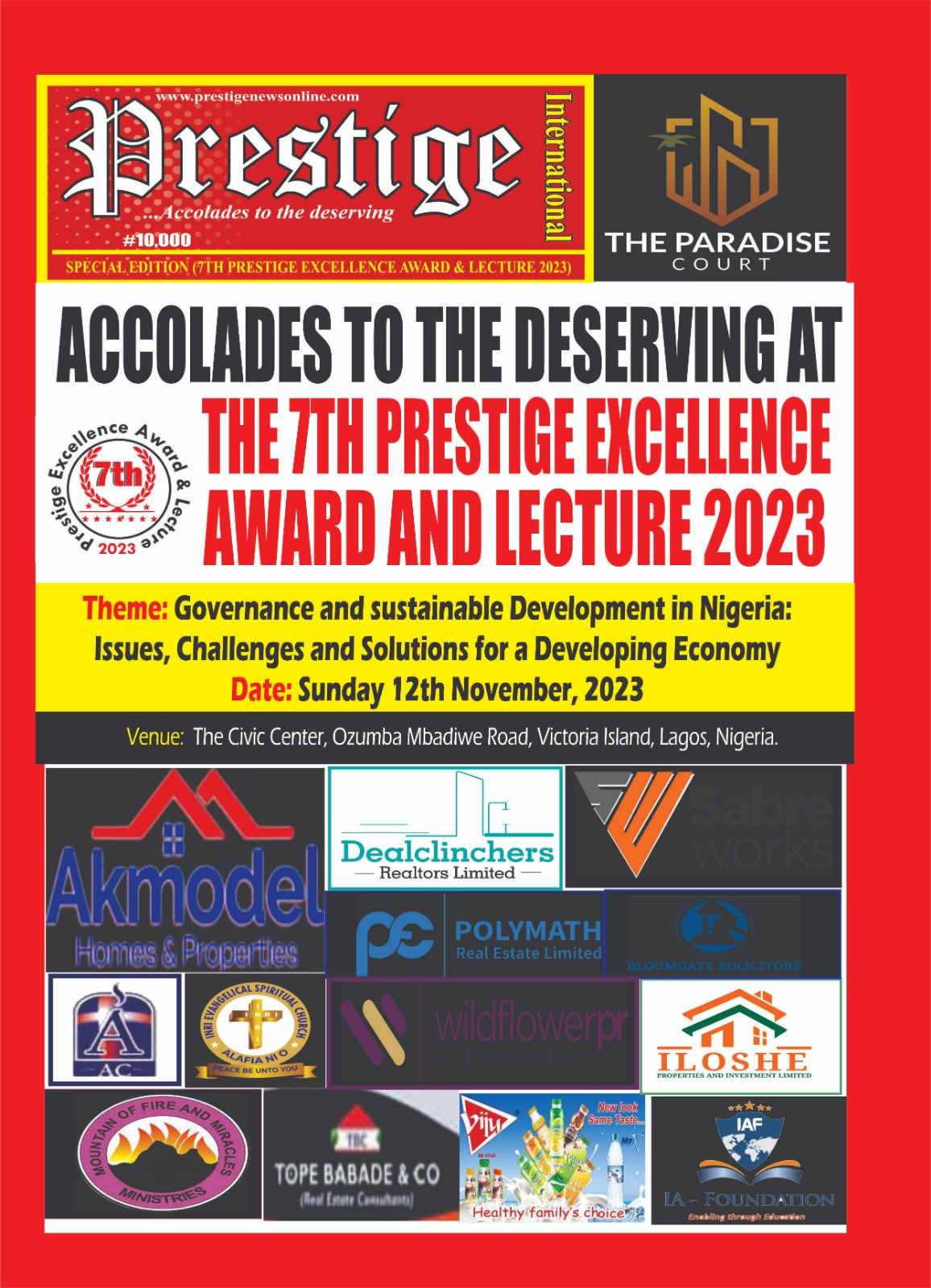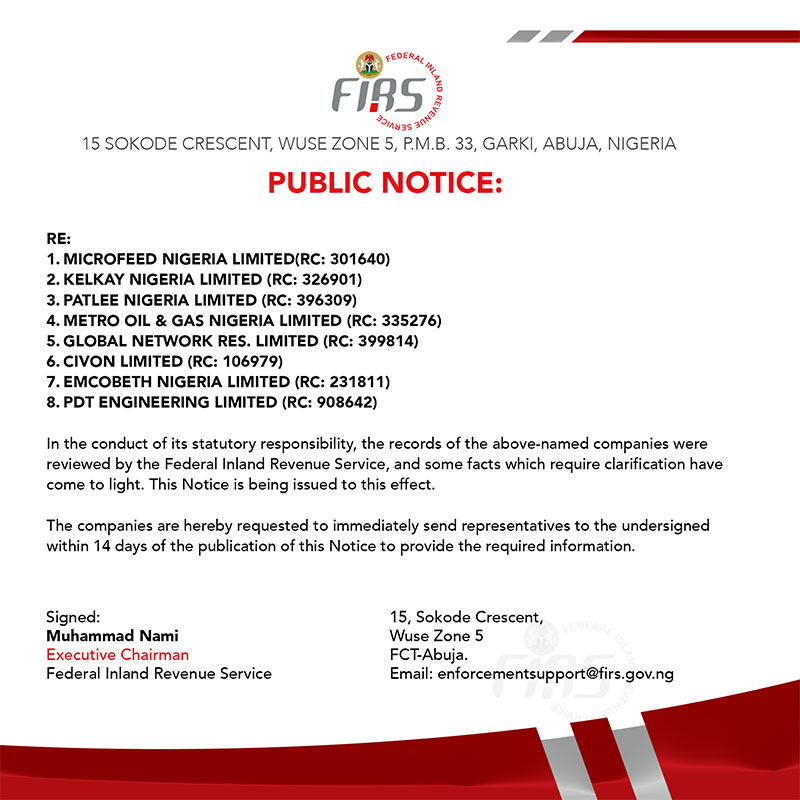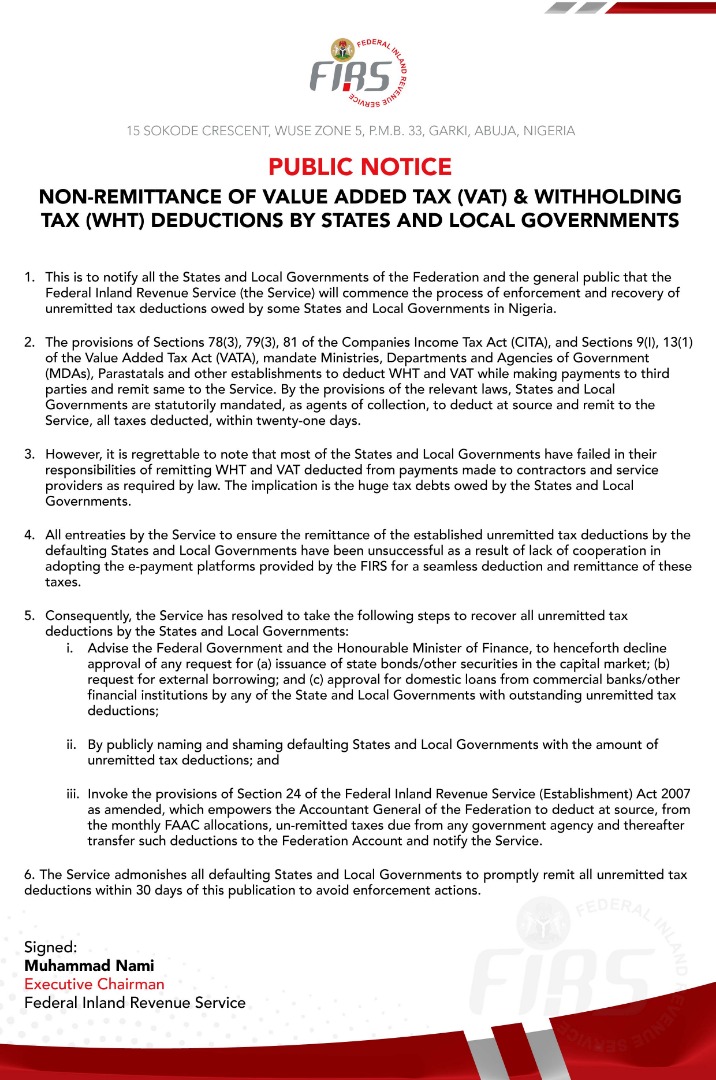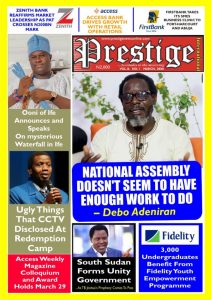
Being Paper Delivered At The 7th Prestige Excellence Award And Lecture 2023 On Sunday November 12, 2023 At The Civic Centre, Ozumba Mbadiwe Road, Victoria Island, Lagos. By Debo Adeniran
INTRODUCTORY HISTORICAL FLAKES
Nigeria occupies a geographical space of 923,768 Sq.Km with an estimated population of about 200 million. The country was christened by Flora Shaw, wife of its first Governor – General after the amalgamation of the Northern and Southern Protectorates by Sir Fedrick Lugard in 1914. It is a multi-ethnic-nationalities, multi-religion, multi-culture, plural society. The Nation-State called Nigeria has over two hundred and fifty ethnic-nationalities, all with their unique historical trajectories, cultural idiosyncrasies and economic strengths and weaknesses. A cursory examination of the pre-colonial entities constituting present day Nigeria would show the paths of autonomous growth and development of these entities in a way that justifies the assertions in some quarters that Nigeria is a mere ‘geographical expression’.

It is important to emphasize that the various people and societies that were wedded into a non-consensual union of Nigeria were at different historical phase of evolution before the European-British disruption of their paths of developments and socio-economic relations. Research in Comparative History have buttressed the fact that the leading societies in pre-colonial Nigeria were far more advanced, settled and organised as Empires and Kingdoms in terms of structural organisation of City-States, streets layouts and city-walls than their European counterparts. The main comparative advantage of the Europeans was Ship construction, navigation skills and discovery of gunpowder.
Two striking historical epochs of disruption of the developmental strides of Nigerian indigenous societies worth noting. The Trans-Sahara Slave trade by the Arabs commenced the destruction of native social governance system in sub-Saharan Africa in the 10th – 15th Century, this supplanted the Hausa dynasty with the Fulani Jihadists in most parts of the present Northern Nigeria except for the Mai Dunami Kingdom of the Borno Empire in the North-East. In the same manner, the European Trans-Atlantic Slave trade adversely dislocated and depleted the productive forces in the southern society of the country. Slavery, by nature feasted on the youth of societies who are supposed to be most active, productive, and imaginative social segments of any community. A social group that is vital to drive the wheel of development to harness all creative productivity of societies. Recorded slave hunting expeditions showed evidence of grievous, devastating dislocations of the socio-economic relations and production processes of sub-Saharan hinterland communities. This inevitably paved the way for the easy ride of colonial conquests.
The Yoruba, Oyo Empire extended as far as present-day Republics of Benin and Togo, the Benin Kingdom is widely acclaimed as one of the best organised in pre-modern era, the Hausa-Fulani Empire shared affinities with present day Chad, Niger Republic. While the Bornu Empire, though relatively isolated have centuries-long history trade and diplomatic relations with Arab nations as far as Saudi Arabia. The Republican, Industrious, inter-dependent communities in the East, autonomous communities of the South-South and Middle-Belts areas are at different stages of organised. Sedentary developments. It is instructive to note all these communities were viciously yanked off their paths of development and forcefully planted in the European orbits of socio-economic relations through an “Indirect Colonial Rule” administration system in Nigeria. Thus, all the economic potentials of Nigeria as a colonial outpost were geared towards feeding the industrial economies of colonia, British metropolitan cities. This is the pattern of the square roots of our underdevelopment till date.
Despite the 1914 amalgamation, colonial divide and indirect rule system practised at different degrees in different parts of the country ensure that Nigeria never blended or bonded seamlessly as a nation. In 1939, colonial administration compounded the geo-political configuration with the introduction of the Eastern, Western and Northern Nigeria system of colonial governance. Subsequent constitutional re-jigging with the Lyttleton and Independence Constitution, 1954 was unable to address the fundamental imbalances in the polity. The early manifest of this problematic after independence were the creation of the Mid-West Region in 1963, the Isaac Adaka Boro led rebellion for Niger Delta Republic and the Biafra civil war.
HIGHLIGHTS OF GOVERNANCE AND DEVELOPMENTAL PATHS, 1960 -1999
A rather sad commentary that Sixty-Three years after independence, successive leaderships and administrations have not found lasting, concrete panacea to the myriads of barriers deterring attainment of good governance and development in the country. The country contends with acute economic crisis of cyclical recession, inflation, stagnation, de-industrialisation, unemployment, poverty, inequalities, corruption, ruination of rural economies, urban slums, crimes, terrorism, insecurity of lives and properties and collapse of essential social, infrastructural facilities, Peer reviews of nations that were considered as developing, non-aligned in Nigeria’s bracket line in the 60’s and 70’s like India, Brazil, Malaysia, Indonesia, or continental compeers like Egypt, Ghana, Angola, Rwanda, South Africa have now successfully discovered their developmental strides into global economic orbit,
How did Nigeria miss the voyage to responsible good governance and sustainable, socio-economic advancement? Several Constitutional Review mechanisms for the 1979 as well as 1999 Constitutions have been grossly defective at aggregating consensus of composite amalgams of ethnic nationalities. Justice has never been done to the near altruistic provisions of Chapter Two of the Constitution on “Fundamental Objectives and Directive Principles of state Policy”. Examination of the First Republic and the Military Interregnum in Governance would shed useful lights on like rationales behind missed journeys to developmental leap and good governance in Nigeria.
FIRST REPUBLIC, 1960 – 1966
Nigeria inherited a skewed Federal system of Government with three regions in 1960, North, East and West in 1960, though the Mid-West region was created in 1963. It runs a parliamentary mode of governance. This largely allowed the regions to address developmental plans at their pertinent regional pace without any region holding down another. According to Prof. Kenneth Wheare in “Federal Government”, federation has three tiers, Federal, State and Local tiers and federating units shares powers and areas of influence, he submitted that, “It is undesirable that one or two units (in a federation) should be so powerful that they can overrule the others and bend the will of the Federal Government to itself… there must be some sort of reasonable balance with which the units can maintain their independence within the space allotted to them and that no one can dominate the others”.
Inability of the major players in the political leadership of the nation to manage this intricate balance of the federating units viz the Federal might was responsible for the crisis that signalled the death knell of the First Republic. The three regions embarked on independence journey as semi-autonomous regions within the federating units, in control of their resources, remitting constitutionally stipulated revenues, taxes and levies to the Federal Government. The famed Groundnuts pyramids in the North, Cocoa pyramids in the West and Palm Oil float in the East were picturesque symbol of each region pursuing areas of comparative advantages in Agricultural resources to contribute to the national economy.
The Federal Constitution delineated areas of jurisdiction for the tiers of government – Exclusive List which include defence of territorial sovereignty for the Federal Government, the Concurrent List is run by both the Federal and Regional Governments while the Residual List are strictly under the jurisdictional scope of the Regions. The regions deployed revenues raised to address their basic infrastructural needs and developmental plans. There was seeming passion by the regions to junction into the world developmental orbits as an emerging industrial nation.
Beyond the symbolic Agro-industry displays, the regions pursue lines of developments that specific to their regions; the North was noted for Textile industries and support for the Talakawas, the East for Trade and Enterprise, while the West toe the line of social welfare and Industrialisation. No doubt, the West was journeying into modern, industrial economy at a faster pace than the other regions with industrial complex in Ogba-Ikeja axis, Otta-Agbara complex, infrastructural advancements in education, road, pipe borne water, healthcare, and even ambitious projects like first broadcasting station and Cocoa House. However, an intra-party leadership tussle of Action Group, the party in control of the Western Region created for avenues for the Federal Government to meddle into the affairs of the regions leading to a chain of reactions that invariably consumed the First Republic, provoking the first military take over on January 15, 1966, and attendant three years civil war.
MILITARY INTERREGNUM
There were two phases of military interruptions in the nation’s governance political space: after the First Republic – 1966 -1979, and after the Second Republic, 1983 -1999. Both have similarities in terms of skewing up the Federal system of governance and bastardisation of socio-economic relations in the polity. There is a unanimous of verdicts that the Military runs a Command Structure and introduced a “Unitary System” of governing the polity which till date reflects in the warped Federal system as the central government wield too much, unconstitutional powers. Natural resources of the regions were hijacked by the Federal Government that now whimsically grants allocations to the units.
The Yakubu Gowon military regime in desperation to avert looming sceptre of civil war, created Twelve States for the Federation in 1967. All other States’ creation were carried out by fiat of military decree. States’ creation was ostensibly to assuage agitations by minority ethnic nationalities in the various States established. The military entrenched a lopsided federal system where the Federal Government becomes overbearing over other tiers of government. The process was kick started with the Petroleum Decree 51 of 1967, giving exclusive ownership of petroleum resources to the Federal Government. This was finalized in the grundnorms of the country as Section 44 (3) of the 1999 Constitution provided that “…the entire property in and control of all mineral oils and natural gas on, under or upon the territorial waters and the exclusive shores of Nigeria shall vest in the government of the Federation”. Subsequently, the Federal Government has full, exclusive preserve over all minerals and natural endowments of the federation.
It is critical to note that these was a period when the world was divided into the West and East sphere of influence, capitalism, and socialism respectively. Nigeria joined the Non-Aligned Movement and adopted the “Mixed Economy” for its macro-economic policies. Thus, the State invested heavily in the provision social infrastructure, education, healthcare, mass housing etc, industries and enterprises. The economy is run based on short and long term “Developmental Plans”.
In 1979 when the military exited our governance space, true federalism has become mere appellations while unitary system has been effectively entrenched. The Second Republic, 1979 – 1983, inherited warped federal institutions and subsist under bad economic austerities measures to merit any innovative mention. However, the succeeding military junta particularly the Rtd. Gen. Ibrahim Babangida regime contributed immensely to shaping the future of the country.
Babangida, generally called the “Evil Genius” came into power at the period of the collapse of former Soviet Russia and the Eastern Europe Socialist bloc. Despite organising a “Cookie’s Bureau”, which recommended a Two- Party System and Socialist Economy for the country. The General went south with his ‘maradonic’ dribbling tactics of ‘a little to the left, a little to the right’ philosophy. He unfurled full-blown neo-liberal economic policies under the Structural Adjustment Program, SAP, goaded by global financial institutions for reforms. He commenced the privatisation and commercialisation policies of government, every other policy direction along that line like the Bureau of Public Enterprises, BPE are constructed on the pillars of the foundation of neo-liberal economic reforms laid by Babangida military administration.
The junta prosecuted political reforms that heightened the centralization of the reins of governance, which further skewed the federal system. He organised a costly, elaborate political transition program that though produced what was generally accepted, although not democratically compliance, to be the freest and fairest Presidential election on June 12, 1993, with late Chief MKO Abiola being victorious, it was never designed to hand over power to civilian administration. This and other grievances against the system provoked agitations for reforms and restructuring of the federation, with open clamour for the convocation of a Sovereign National Conference, SNC. Just as the pro-democracy wave boils up, there were agitations for resource control, minority rights of ethnic-nationalities and socio-economic justice for the masses.
As Odia Ofeimun captures it, the clamour for restructuring is about “…a change in the spatial arrangements by which we are governed”. The various Constitutional Conferences organised by the military tried to rectify institutional errors entrenched during military incursion into the polity with inclusion of Chapter 2 and 4 in the Constitution. Chapter Two laid out “Fundamental Objectives and Directive Principles of State Policy”, which laudable goals but not justiciable, while Chapter Four established fundamental, inalienable, human rights of citizens which justiciable. Despite the inclusion of these clauses, the 1979 and 1999 military-imposed Constitutions, they were not autochthonous, and are fundamentally defective because it did not meet the aspirations of consensual self-government by the ethnic nationalities. The agitations for reforms of governance and restructuring of the polity for sustainable development persist and subsist into the span of the extant Third Republic.
GOVERNANCE IN THE THIRD REPUBLIC
This Republic inherited defective Constitution and Governance structure from military absolutism, which often inhibit developmental strides. A periscopic appraisal shows that Nigerian government structure has taken on different garbs from 1960, when she gained her independence; civilian, parliamentary, military, diarchy with interim regimes and presidential, democratic administrations. It has witnessed ethnic-nationalities, religious, and labour-civic class acrimonies, which shape its governance structure.
The recurrent decimal features that consistently dominate Nigerian government include federalism, separation of powers and democracy. The Nigerian government structure is made up of its three tiers, and three arms of government. The levels of government are at the Federal, State and Local Government administrations, while the operational arms guarded by the principles of separation of powers and rule of law are the Executives, Legislature and Judiciary.
The Federal Government is the apex body for administration of the country presided over by the President. It is the custodian of the nation’s sovereignty and protect its territorial integrity amongst other onerous responsibilities. It operates through organs like the Federal Executive Council, National Defence Council, National Security Council, National Economic Council, And the Federal Capital Territory. The Federal Government sets out Macro and Micro national policies that govern the country cutting across the States and local Governments of the federation. Besides realizing the incomes and revenues in the exclusive schedules of the constitution, some of the major functions of the Federal Government include provision of amenities which include public education, affordable quality healthcare, electricity, affordable housing, good roads, and other utilities; security of lives and properties; in charge of external relations; and protection of the country from external and internal threats and aggression.
The Thirty-Six States and Federal Capital Territory, FCT are the next tier of government, the States are administered by an elected Governor for a four-year tenure, eligible for another term re-election while the FCT is administered by a Minister appointed by the President. They are constitutionally empowered to serve as the chief executive officers of their respective, delineated jurisdictional spheres. States are created to bring government closer to the citizens and perform duties like the Federal Government except mainly issues related to international relations and defense of territorial integrity.
The Local Government areas are the organs for grassroots governance of the federation, it is the nearest in proximity to the citizens but equally the most emasculated tier because of its lack of Financial Autonomy and political as well as administrative domination by the State Government. The local government council comprises of the local government Chairman, who is the helmsman of the local government areas), and Councilors. There are 774 local government areas in the Nigerian government structure, with Kano having the largest number of 44 and the smallest number of 9 belonging to Bayelsa state. Major functions of the local governments include, registration of births, deaths, and marriage certificates, construction and maintenance of rural roads, street drains, parks, open spaces, and other public highways, establishment, maintenance, and regulation of markets, motor parks, naming of roads, streets, and numbering of houses, provision and maintenance of public conveniences, and refuse disposal, and control and regulation of shops, restaurants, kiosks, and other venues for sales of food.
The three branches of government, Executives, Parliament, and Judiciary are guarded by the principles of division of labour and separation of powers. The Executives runs the administration of government, executing all its policies and programs. It is headed by the President or Governor with their Deputies at the Federal and State levels with cabinet of Ministers or Commissioners respectively while, at the local government, the Chairman is the Chief Executive personnel with the Councilors serving as both its cabinet and legislature.
The Legislative arm of government is essentially established to make laws, pass budgets, and play oversight functions over the executives. It is designed to be separate and independent of other arms of governments to be able effectively serve as checks and balances on the other arms of government. At the Federal level, there is a bicameral legislature, the Senate otherwise referred to as the Red Chamber with 109 members headed by the Senate President, while the other is the House of representatives otherwise known as the Green Chambers with 360 members, headed by the Speaker. The 36 State Governments on the other hand, runs a unicameral legislature.
The Judiciary interpret the laws of the federation and adjudicate over all disputes brought before it. It is an independent arbiter that serve as veritable checks and balance on the other arms of government. Its apex body is the Supreme Court presided over by the Chief Justice of the Federation. It also has an Appeal Court, High Court, and Magistrate court as part of its operational divisions. The judiciary has a labyrinth of other official activities which covers customary adjudication, judicial reviews, and administration of the justice system. Appointments and removals of members of the judiciary are purely through the National Judicial Council as stipulated by the Constitution.
The most vital feature of the governance structure is the federal system, but, as pointed out earlier, it is vicariously abused and trampled upon. Federalism is a system of government in which governmental powers that exists in a country are shared between central government and component region, State and Local Governments.
CONTEMPORARY ISSUES OF SUSTAINABLE DEVELOPMENT
Nigeria is a multi-ethnic and culturally diverse federation of Thirty-Six autonomous States and the Federal Capital Territory. Nigeria contends with many social and economic challenges that include acute, compounded economic stagnation, recession and looming collapse, insecurity, banditry, and kidnappings insurgency by terrorist groups in the north-east, and separatist agitations in the south-east, urban ruination crisis, high unemployment, de-industrialization, zenithal corruption, and clamor for comprehensive restructuring.
ECONOMIC APPRAISAL
Between 2000 and 2014, Nigeria’s economy experienced broad-based and sustained growth of over 7% annually on average, benefitting from favorable global conditions, and macroeconomic and first-stage structural reforms. From 2015-2022, however, growth rates decreased and GDP per capita flattened, driven by monetary and exchange rate policy distortions, increasing fiscal deficits due to lower oil production and a costly fuel subsidy program, increased trade protectionism, and external shocks such as the COVID-19 pandemic. Weakened economic fundamentals led the country’s persistent inflation to reach a 17-year high of 25.8% in August 2023, which, in combination with sluggish growth, is leaving millions of Nigerians in poverty.
Following a change in administration in May 2023, the country is now at a crossroads, and has a unique opportunity to return to a sustainable and inclusive growth path. Recognizing the need to change course, the new administration has undertaken key reforms to restore macroeconomic stability by removing the petroleum subsidy and unifying and significantly liberalizing the exchange rate. These reforms, together with global oil prices remaining above their historical averages, are expected to begin to reduce fiscal pressures, and unwind the critical macroeconomic distortions that held back growth in the past. The economy is expected to grow at an average of 3.4% between 2023 and 2025, benefitting from the reforms undertaken, a recovery in the agriculture and services sectors, and, over time, increased scope for government development spending. If the reform momentum is maintained, concerted efforts to achieve fiscal and monetary policy consolidation, reduce insecurity, strengthen public services, and improve the business environment and openness to trade, could boost investments and productivity, allowing Nigeria to return to a high growth path. Yet, downside risks to the outlook are high, and include fading or reversing the reform drive, domestic and regional instability, as well as climate change effects.
DEVELOPMENT CHALLENGES
Despite having the largest economy and population in Africa, Nigeria offers limited opportunities to most of its citizens. A Nigerian born in 2020 was expected to be a future worker 36% as productive as they could have been if they had full access to education and health, the 7th lowest human capital index in the world. Weak job creation and entrepreneurial prospects stifle the absorption of the 3.5 million Nigerians entering the labour force every year, and many workers choose to emigrate in search of better opportunities. The poverty rate is expected to reach 37% in 2023, with an estimated 84 million Nigerians living below the poverty line — the world’s second-largest poor population after India. Spatial inequality continues to be large, with the best-performing regions of Nigeria comparing favorably to upper middle-income countries, while the worst performing states fare below the average for low-income. In most areas of Nigeria, state capacity is low, service delivery is limited, and insecurity and violence are widespread. Wide infrastructure gaps constrain access to electricity and hinder the domestic economic integration that would allow the country to leverage its large market size. Emerging problems such as the increased severity and frequency of extreme weather events, especially in the northern parts of the country, add to these long-standing development challenges.
Recent reforms offer a launching pad to a new social compact for Nigeria’s development. Strengthening macroeconomic fundamentals will allow structural reforms to be pursued and economic growth to be restored. The current low social and economic equilibrium could be switched to one marked by a better funded and more effective State that provides efficient public services, public goods, and a conducive economic environment for the private sector to flourish and create more quality jobs for Nigerians.
This administration has expressed commitment to tackle myriads of socio-economic and developmental problems confronting the nation with the instrumentality of United Nations’ Social Development Goals
The SDGs were adopted by the UN in 2015 to replace the Millennium Development Goals. They are seventeen (17) interlinked objectives conceptualized to harnessed developmental potentials of countries across the world. It is “shared blueprint for peace and prosperity for people, planet now and into the future”. It comprises of SDG 1- Elimination of Poverty; SDG 2- Zero Tolerance to Hunger; SDG 3 – Good Healthcare and Wellbeing of Citizens; SDG 4 – Quality Education; SDG 5 – Gender Equality; SDG 6 – Cleen Water and Sanitation; SDG 7 – Affordable and Cleen Energy; SDG 8 – Decent Work and Economic Growth; SDG 9 – industry, innovation and Infrastructure; SDG 10 – Reduced Inequalities; SDG 11 – Sustainable Cities and Communities; SDG 12 – RESPONSIBLE Consumption and Production; SDG 13 – Climate Change; SDG 14 – Preservation of Life Below Water; SDG 15 – Preservation of Life on Land; SDG 16 – Peace, Justice and Strong Institutions; and, SDG 17 – Partnerships for the Goals.
The main focus for all is … Time would tell how far we actualize these goals.
Thank you.
Debo Adeniran
Chairman, Centre for Anti Corruption and Open Leadership,
CACOL
President, Committee for the Defence of Human Rights, CDHR
08037194969






























